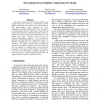Free Online Productivity Tools
i2Speak
i2Symbol
i2OCR
iTex2Img
iWeb2Print
iWeb2Shot
i2Type
iPdf2Split
iPdf2Merge
i2Bopomofo
i2Arabic
i2Style
i2Image
i2PDF
iLatex2Rtf
Sci2ools
HICSS
2009
IEEE
2009
IEEE
Reexamining Threat Rigidity: Implications for Design
Emergencies today seem larger, more complex, and unique than those of the past. Responding to them requires flexibility and creativity not easily achieved. The threat-rigidity thesis proposed by Staw, Sandelands, and Dutton [23] proposes that response to an environmental threat is often one of constriction of control and restriction of information that results in a rigidity of response that can be maladaptive in a new and/or large crisis. However, there are ways to mitigate maladaptive responses. For example, the principles of High Reliability Organizations and Crew Resource Management can ameliorate rigidity of response. In a synthesis of the theory and empirical results from a number of different areas we show how they fit together to explain some of the observed properties of the threat rigidity syndrome. We propose a model of an individual’s cognitive responses to threat and review system design principles that can support flexible, adaptive responses in crisis.
Biometrics | HICSS 2009 | Maladaptive Responses | Rigidity | System Sciences | Threat Rigidity Syndrome |
| Added | 19 May 2010 |
| Updated | 19 May 2010 |
| Type | Conference |
| Year | 2009 |
| Where | HICSS |
| Authors | Linda Plotnick, Murray Turoff, Gerd Van Den Eede |
Comments (0)

